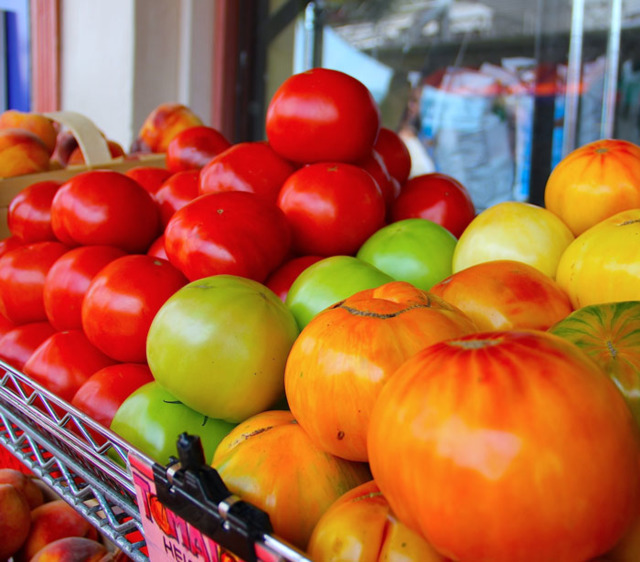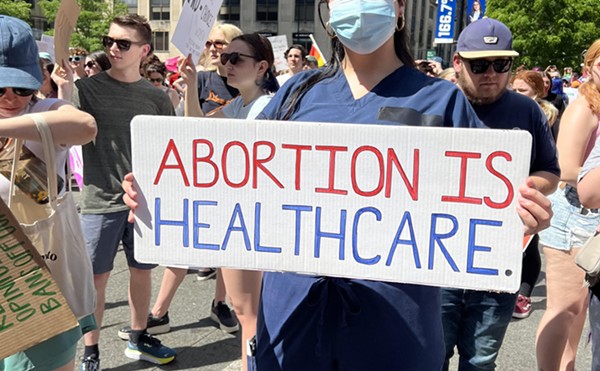A local group wants to change the way large institutions like schools and hospitals buy food to make it more nutritious, sustainable and fair. Their preferred approach — called the Good Food Purchasing Program (GFPP) — has been adopted in cities like Los Angeles. Could it work here, too?
The Greater Cincinnati Good Food Coalition and the Cincinnati Interfaith Workers’ Center hosted a panel of activist groups at the First Unitarian Church in Corryville last week to discuss the possibility of revamping Cincinnati’s food system.
Representatives from the Union of Concerned Scientists, the United Food & Commercial Workers International Union, the American Society for the Prevention of Cruelty to Animals and Slow Food Cincinnati attended that panel.
“The system we have now, by and large, causes environmental pollution (and) degradation of natural resources,” Sarah Reinhardt of the Union for Concerned Scientists told attendees. “It doesn’t necessarily respect the animals that are a part of that livestock system, it doesn’t provide livable wages for the workers most of the time and in fact exploits a lot of workers.”
The GFPP outlines five priorities that proponents believe are essential to an improved food system: increased development of local economies, ecological sustainability, how workers are treated, nutrition and animal welfare. The main way the initiative looks to improve these categories is by the way it purchases food.
Rather than buying food from factory farms, the GFPP aims to have institutions buy from local farmers to invest in the local economy.
That could be a big deal for workers — especially when it comes to those who process poultry, which has seen increased demands as drought ravages beef and other meat industries. Dennis Olson of the United Food & Commercial Workers Union says only about a third of the poultry industry’s workforce is unionized, unlike other meat-processing industries, where between half and three quarters are.
One reason for that disparity: a good deal of America’s poultry is processed in prison labor facilities.
Across food industries, workers in the supply chain often lack labor rights and work in poor conditions, activists on the panel said, but the GFPP could help them advocate for their rights.
The GFPP also aims to raise the standards for the nutritional value of the food that institutions have to purchase, as well as ensure that the meat is from well-raised animals as opposed to factory farms.
Suzanne McMillan of the ASPCA pointed out that about 10 billion land animals per year are being raised for food in the U.S. alone. “We have very, very few laws, either state or federal, that control how farm animals are to be raised,” she said. “And not only raised but also transported and slaughtered. So when you bring that all together it becomes even more important to try to secure corporate commitments and institutional commitments for improvements.”
As part of the GFPP, the ASPCA has a two-pronged approach to how institutions could improve animal welfare: They could either buy from sources with higher welfare standards or purchase a lower volume of food.
There are multiple fronts on which coalition members must strike a delicate balance. Olson of the UFCW emphasized the need to keep in mind the traditional supply chain which includes factory farms and processing plants that hire many union workers. This clashes with the idea of shifting purchasing all the way over to local farmers who hire fewer workers and typically cause less pollution.
One audience member asked how local farmers would be able to produce enough food for Cincinnati’s institutions. Reinhardt of UCS offered possible solutions such as food hubs, storage and packaging facilities and cooperatives, which have been used in other cities.
The Good Food Purchasing Program has already been implemented in a number of other cities including Austin, Texas; Chicago; Los Angeles; Madison, Wisc.; New York; Oakland, Calif.; San Francisco; and the Twin Cities.
UCS did a case study on the Los Angeles food system after the GFPP was implemented there in 2012. L.A. currently sources about 20 percent of its food locally, which benefits the local economy by an estimated $48-$94 million a year. The economic model for the study found that this investment supported more than 260 jobs. UCS was available to validate at least 220 jobs through news reports.
A huge player in L.A.’s institutional food system is the Los Angeles Unified School District, which serves about 650,000 meals per day. Since 2011, over $13 million of the district’s money has been redirected toward local farmers, processors, warehouses, distributors and workers. The school also switched to 100-percent sustainable wheat flour buns as of 2014 and implemented “Meatless Mondays,” which reduced the school’s carbon footprint by about 22 percent and water use by an estimated 1.2 billion gallons per year.
The Greater Cincinnati Good Food Coalition is trying to implement the GFPP as part of The Green Cincinnati plan which, put in place in 2008 and readopted in 2013, aims to increase sustainability in Cincinnati.
Zac Perrin is a University of Cincinnati student and CityBeat intern.






